Description
object_id
In contrast to parietal art, often found on rock walls in caves or in rock shelters, mobile artefacts usually come from excavated stratigraphical units. These artefacts constitute the key elements in SignBase. Each mobile object receives an ID. This consists of an abbreviation of the site name, followed by a four digit running number assigned within our collection:
Examples
Blanchard: bla0001, bla0002, etc.
Castanet: cas0001, cas0002, etc.
La Ferrassie: laf0001, laf0002, etc.
Vogelherd Cave: vhc0001, vhc0002, etc.
Hohle Fels Cave: hfc0001, hfc0002, etc.
ensemble_id
Mobile objects can be part of an ensemble. This means they were found in close association in a given archaeological layer. For example, in the case of grave goods in a burial. The ensemble ID consists of the three letter abbreviation of the site name, followed by underscore, followed by the abbreviation "ens", followed by underscore, followed by a two digit running number.
Examples
Saint Germain de la Rivière burial: sgr_ens_01
archaeological_period
Entities in Prehistory are based on material culture. An archaeological technocomplex is a characteristic collection of technologies that might extent over vast geographic areas and time depths. The most general term used here to refer to technocomplexes is archaeological period. In the Paleolithic, this might be for example the Lower Paleolithic (associated with the earliest stone tool technologies from the Lomekwian, to Oldowan, and Acheulean), the Middle Paleolithic (typically associated with prepared core technologies like Levallois), or the Upper Paleolithic (defined by a panoply if different tool types and cultural artefacts like ivory figurines) for Europe, but also the Middle Stone Age (MSA) or the Later Stone Age (LSA) in Africa.
Examples
Lower Paleolithic
Middle Paleolithic
Upper Paleolithic
Mesolithic
etc.
archaeological_unit
Archaeological periods are often subcategorized into finer-grained archaeological entities, which we here call archaeological unit. For the Upper Paleolithic, this might be for example the Aurignacian (named after the site Aurigniac), the Gravettian (named after La Gravette), or the Magdalenian (named after La Madeleine) in Europe.
Examples
Mousterian
Aurignacian
Gravettian
Pavlovian
Epigravettian
Magdalenian
etc.
site_name, site_id, location, country, latitude, longitude, etc.
All the objects in SignBase are finds from archaeological excavations in caves or open-air sites. The name of the archaeological site (site_name) is provided, abbreviated to a three letter ID (site_id), as well as the closest community or town (location) and the country (country). The latitude and longitude coordinates are also given (if possible for the site). The precision of the coordinates (coord_precision) takes the value precise, if the coordinates correspond to the exact geographic location of the site, and take the value approximate, if only the coordinates of the closest community or town are available. The coordinate reference (coord_reference) is given as well. This can be the excavation report or an internet site, e.g. wikipedia.
Example
site_name: Hohle Fels
site_id: hfc
location: Schelklingen
country: Germany
latitude: 48.379117
longitude: 9.754103
coord_precision: precise
coord_reference: wikipedia
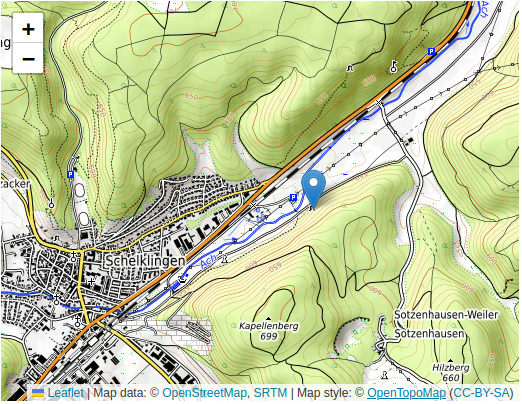
layer
In archaeological excavations, objects are found in units of sediments, which are called stratigraphical units or layers. These units are usually defined by the archaeologists during excavation and give information about the provenience of the object and its assignment to a particular archaeological unit (i.e. a material culture, technocomplex).
Example
Layers in Hohle Fels (hfc): IId, IIe, IIIa, IIIb, IV, Va, etc.
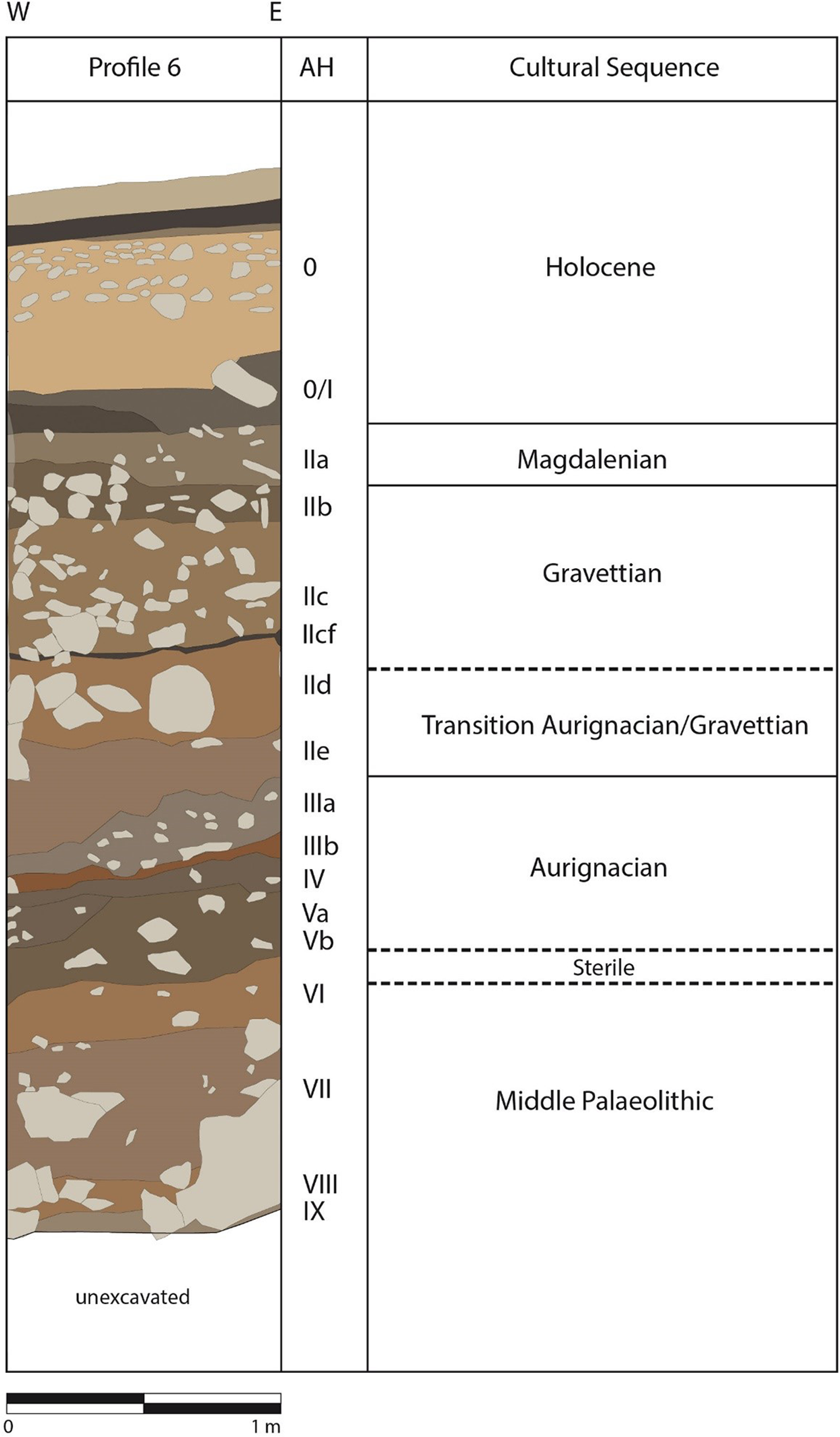
Velliky EC, Porr M, Conard NJ (2018) Ochre and pigment use at Hohle Fels cave: Results of the first systematic review of ochre and ochre-related artefacts from the Upper Palaeolithic in Germany. PLoS ONE 13(12): e0209874. https://doi.org/10.1371/journal.pone.0209874
dating_method
This provides the method that has been used for dating the find. Dates are normally obtained through direct dating of layers or objects, or taken over from the given archaeological unit. For absolute dating in Prehistory mainly radiocarbon dating (C14) is used. Other possible methods are Accelerator Mass Spectrometry (AMS), Thermoluminescence (TL), Optically Stimulated Luminescence (OSL), or Uranium–Thorium dating (UT).
date_bp_min, date_bp_max, min_lab_number, max_lab_number
Minimum and maximum dates (date_bp_min, date_bp_max) are provided if available. The laboratory which provided the dating is identified with a lab number. The lab providing the minimum date (min_lab_number) can differ from the lab providing the maximum date (max_lab_number). BP is the abbreviation for "before present" – a time scale used mainly in archaeology. The commencement date of the age scale ("present") is 1 January 1950, reflecting the origin of practical radiocarbon dating in the 1950s. Here, uncalibrated dates are given.
material
Raw material the object is made of. For the Paleolithic, mostly osseous material, like ivory, bone, or antler is used. Other organic materials, like shells of mollusks, egg shells, or teeth, but also inorganic materials like rocks, pigments, or ceramics might appear.
Example
ivory, antler, shell, limestone,
flint, ochre
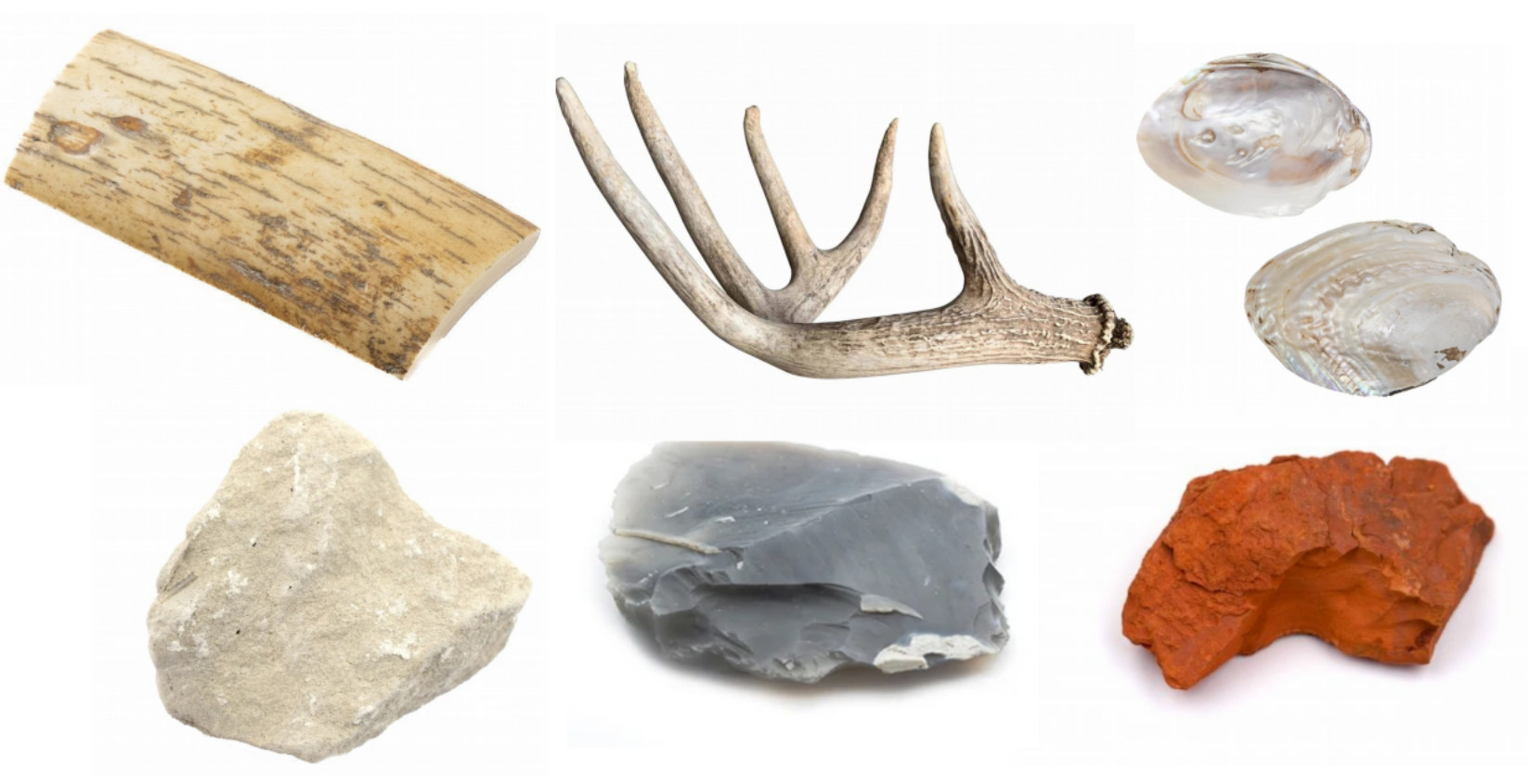
material_species
The genus and species of the animal from which the material (bone, antler, ivory, etc.) was taken for crafting a mobile artefact – if identifiable. The name of the genus comes first, followed by the species specification (e.g. Mammuthus primigenius). If only the genus is identifiable, then the species name is dropped. Note: "material species" is not to be confused with the species depicted by a figurine or on another mobile artefact. The latter is called "associated species" (see below). If the determination of the material species is not possible due to taphonomic processes, then this field takes the value undetermined. If there is simply no information on this in the literature, then the field is just left empty.
Example
Mammuthus primigenius ("woolly mammoth"), Cervus elaphus ("red deer"), Rangifer tarandus ("reindeer"), etc.
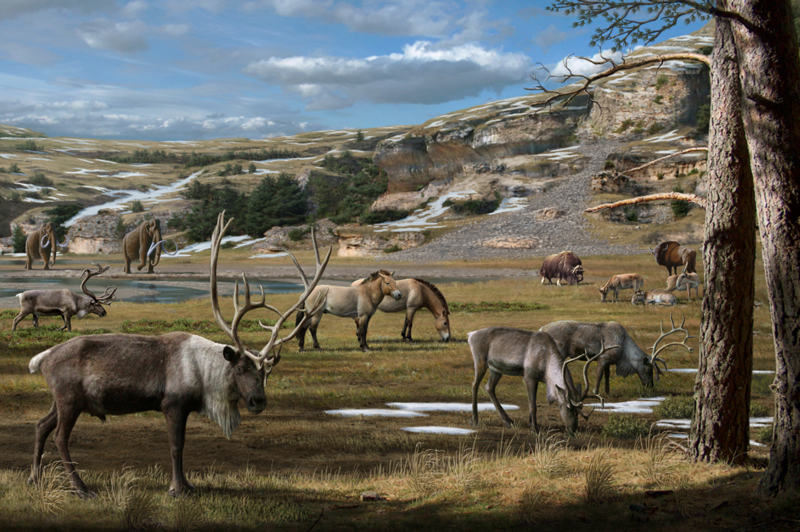
Illustration: Mauricio Anton
object_type
Typological determination of the object, usually as indicated in the literature, or revised, if needed. Might be tools such as awl, spatula/lissoir, rod/baton, or flute, personal ornament, figurine zoomorph, figurine anthropomorph, or any other archaeological type of object. Note that slashes are used when it is not clear if an object is of one or the other type, e.g. tube/flute means that there is a bone piece which could be a tube or (part of) a flute. Generally, English archaeological terms are used if available (e.g. perforated baton instead of bâton perforé). If the type cannot be determined this field is given as undetermined.
Example
figurine anthropomorph, figurine zoomorph, spatula/lissoir, rod/baton, flute, personal ornament

associated_species
The genus and species of the animal which is depicted by a figurine or by an engraving – if identifiable. The name of the genus comes first, followed by the species specification (e.g. Mammuthus primigenius). If only the genus is identifiable, then the species name is dropped (e.g. Panthera for some species of feline not further identifiable). Note: the "associated species" is not to be confused with the species which the material for the mobile object is derived from (e.g. by using its bone, antler, ivory). The latter is called "material species" (see above). If the object is a figurine or figurine zoomorph without any identifiable genus or species, then this field is given as undetermined, otherwise (e.g. when the object is a tool) the field is just empty.
Example
Mammuthus primigenius ("woolly mammoth"), Equus ferus ("wild horse''), Panthera spelaea ("cave lion"), Bison priscus ("steppe bison''), Ursus spelaeus ("cave bear"), Osteichthyes ("fish", species not further specified), Anatidae ("water bird", species not further specified)

Illustration: Mauricio Anton
length_mm, width_mm, depth_mm
Gives the dimensions of the object in millimeters (mm). Usually as indicated in the literature.
Example
Mammoth figurine from Vogelherd cave (vhc0145)
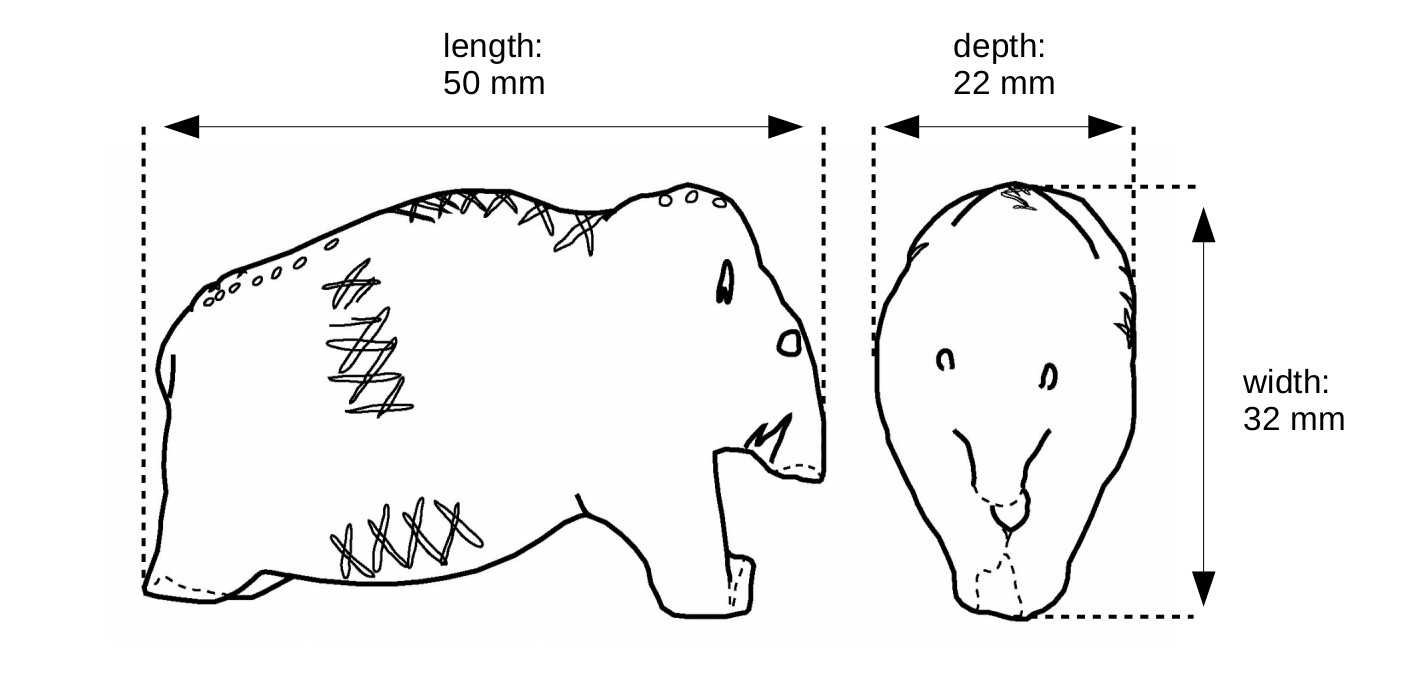
preservation
State of preservation of the object.
complete – the whole object is preserved.
almost complete – the shape of the object is largely preserved, with some damage.
fragmented – only a partly preserved object, the original dimension and shape of the object is not straightforwardly derivable.
Example
Mammoth figurine from Vogelherd cave (vhc0090)

short_description
A short text describing the object, circumstances of its excavation, and further potentially relevant information. This can also include comments necessary for contextualizing the object, as well as potential identfiers from other publications. Note that this is the only column where running text is used.
Example
Object from Hohle Fels cave (hfc0027)
Find number: 68-2286. This is part of a recently refitted figurine of a bear. Body was found in 2022 and this "horse head" (hfc0027) and shoulder part (hfc0026) were added. Both data sets, hfc0025 and hfc0027 were summarized in hfc0026, the coding here was deleted.
collection, collection_id
The respective collection where a given mobile artefact is located. These are typically museums, but also institutions like universities and academies of sciences. These institutions typically have their own collection IDs assigned to the mobile artefacts. These IDs are vital for finding a given artefact in the catalogues and magazines at the respective institution. The collection IDs might be built on the so called "find number" assigned to objects directly at an archaeological excavation, but in some cases these are yet different. When collection IDs are not available, the find numbers might also be given in this field.
Example
object_id (SignBase): agg0001
collection: Naturhistorisches Museum Wien
collection_id: NHMW-Prae-46171
references
Literature references for the given object, typically with information on its provenience, excavation report, and dating of the object/stratigraphical unit.
sign_coding
Coding of the geometric signs found on an object. In the context of Paleolithic mobile artefacts we define the term sign as a manipulation of a surface which can be perceived and interpreted by an intelligent viewer. Note that this includes bite marks, cut marks, functional manipulations, etc. In our analyses, we restrict this further to intentional and non-utilitarian signs. "Intentional" means that they are not the by-product of another activity, e.g. cut marks as a result of butchering. "Non-utilitarian" means there is no indication that these surface manipulations had purely practical functions, e.g. holes for attaching ropes, or circular incisions to help with hafting. The term "geometric" points to the fact that these signs mostly consist of abstract shapes which are not obviously depictions of things perceived in the world.
Sign Types
We define a set of geometric sign types found across different Paleolithic time periods. An up-to-date complete list with these sign types, their names in signBase, and their UTF-8 character representation is given in the Download section. Some examples of sign types are given in the panel below. This includes snapshots of sign tokens, schematic drawings, the sign type names, and the UTF-8 characters representing them in our coding. The focus of this data base is on geometric signs. However, some geometric depictions, e.g. of animals or vulvae might also be included.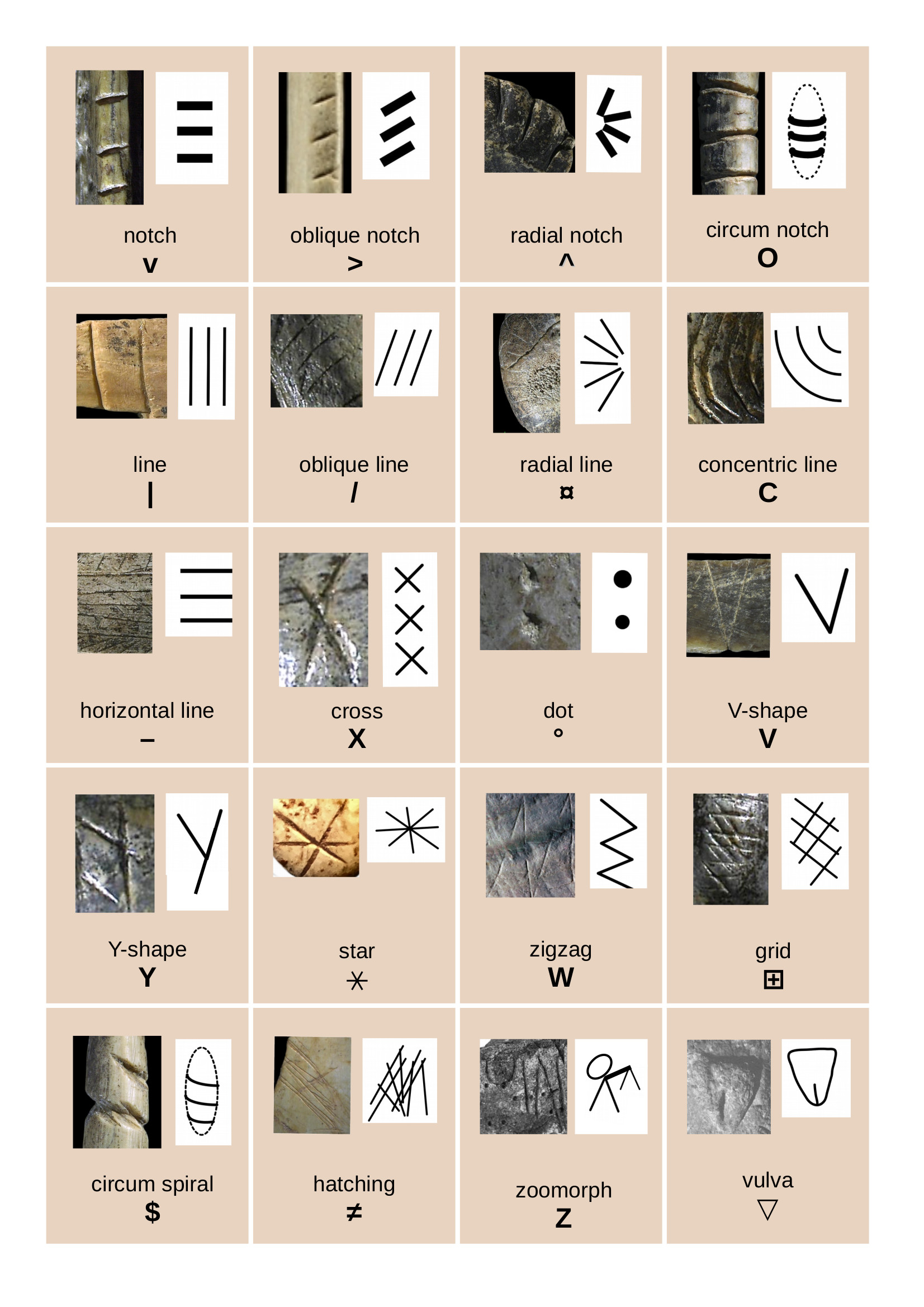
Sign Strings
Besides UTF-8 characters representing actual sign types, there are also characters used for annotation purposes. Namely, we code strings of signs according to the following principles:- A concatenation of sign tokens, i.e. a sign string, generally represents discrete signs which are arranged in visible linear order on the object.
- If the signs are not in linear order on the object, but still grouped in visual fields, then we put them in square brackets, i.e. <[ ]>.
- Signs which overlap (i.e. are non-discrete) are marked with round brackets i.e. <( )>.
- Signs which stand out as non-calibrated with regards to one another are marked by curly brackets <{ }>. Note: calibration means that signs have roughly the same size.
- If parts of the object are broken off, such that this breakage influences a string of signs as well, then an exclamation mark <!> is put at the respective position where the break occurs.
- If several sign strings are concatenated in a linear fashion on the object, then we use a single white space < > to represent the linear visual separation also in the sign coding.

Sign Sequences
Mobile objects are the core unit of our data base which are also associated with the meta information (geography, dating, object type, etc.). Each mobile object might carry several sign strings. In the sign coding, these are concatenated to yield a sign sequence for the whole object. This means that sign strings on different parts of the object are concatenated using underscores < _ >.An illustration of the process of creating a sign coding is given for a mammoth figurine of the Vogelherd Cave (vhc0145) below. Note that in such a sign coding, the order of signs in strings is meaningful, i.e. it represents the actual linear order on an object (though the direction is arbitrary). However, the order of strings (delimited by underscores) in whole sequences is arbitrary.
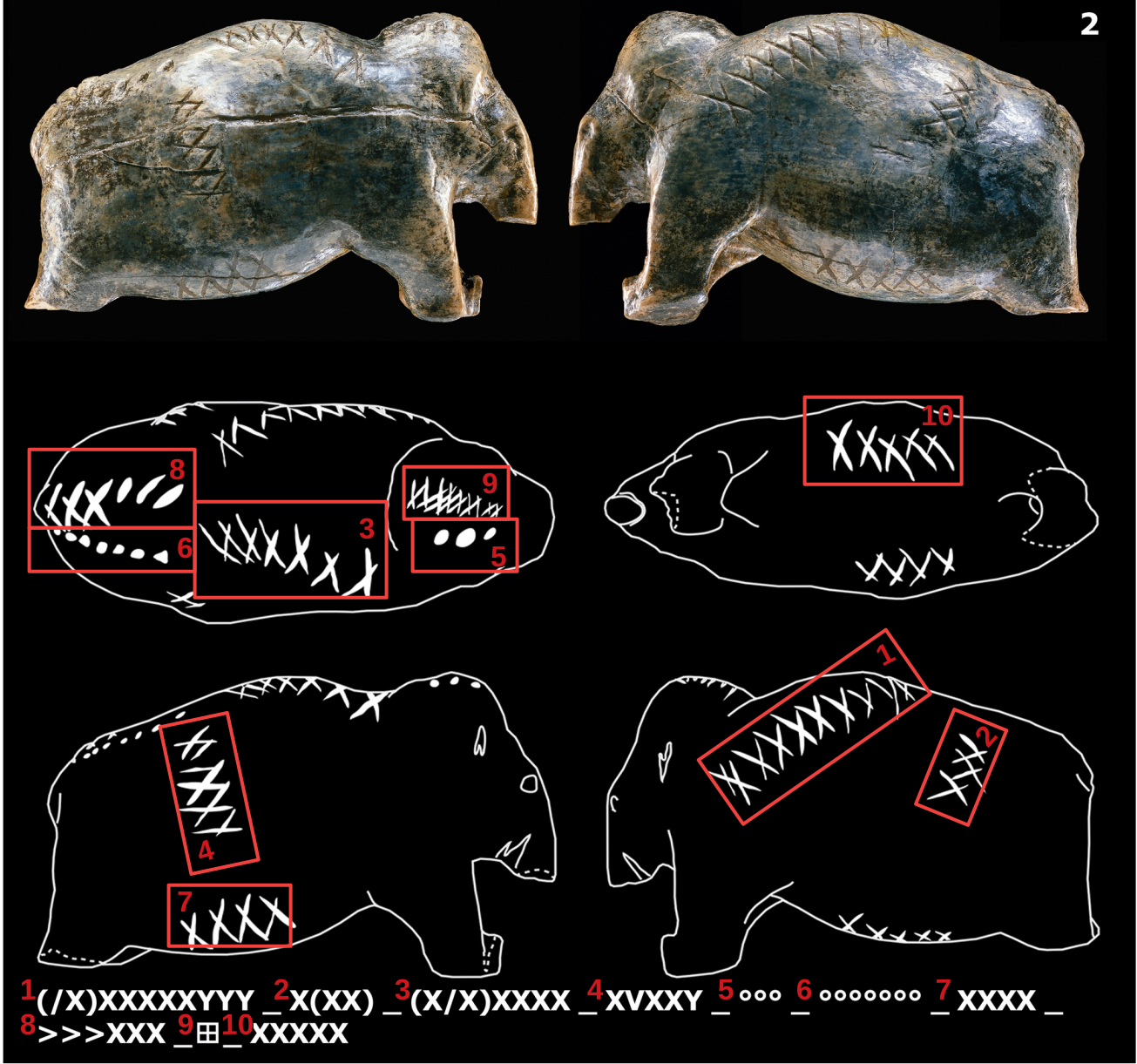
coding_certainty
Sign codings will always be subjective to some degree. For each sign coding per object we provide factorial values of coding certainty.
- very certain – the signs have been inspected on the original objects (microscope or naked eye) or high resolution pictures, and have been found to be clearly worked out as visually distinguishable, coherent units.
- certain – the signs have been inspected directly on the objects or based on high resolution pictures, with potentially minor doubts about the clarity of signs as coherent units.
- uncertain – significant doubts about the exact sign codings due to lower quality of pictures, or due to lower quality of worked out strokes in case of direct observation.
- very uncertain – high uncertainty due to low quality of pictures, or low quality of worked out strokes.